You can’t expect new results if you keep doing the same thing.
One of my New Year’s resolutions is to start creating videos. Another is to learn how to use the latest Artificial Intelligence tools available on the market. So, why not combine the two?
Table of Contents
How I Used AI to Create My First YouTube Video
Even before 2025 begins, I decided to conduct my first experiment: creating a 3-minute video. I chose self-improvement as the theme because, while working on it, I found myself motivated by those familiar inspirational phrases we all know but often forget to apply in our daily lives. After all, knowledge without action is nearly useless.
Step 1: Writing the video script
I already knew the theme I wanted for my video, so I asked ChatGPT to create the video structure, including the narrator’s text and suggested scenes.
I decided to make the video in English to reach a broader audience. I wanted to challenge myself on a global scale, not limit my reach to Italy or Brazil.
Additionally, many AI tools tend to work better in English, especially for features like automatically generated voices with accurate pronunciation.
Step 2: Creating video images with Artificial Intelligence
I was searching for an AI tool that could generate full videos, but I haven’t found the right one yet.
Instead, I used Leonardo.ai to create images. Some of these images include slight movements, which is an interesting feature, though not yet effective for depicting people or complex actions.

Leonardo.ai offers a variety of pre-set image styles, which is a fantastic feature for those looking to quickly experiment with different visual aesthetics. However, the platform still faces some challenges, such as frequently generating images of people with six fingers or struggling to correctly render text in images. These limitations can be frustrating but are part of the ongoing refinement process for AI-generated visuals.

Leonardo.ai offers a free version, but it’s mainly for testing the platform. Creating a full 3-minute video is impossible without a subscription. So, I subscribed to the “Apprentice” plan for $12 per month (plus taxes). If I continue making videos regularly, I might need to upgrade. For now, this plan seems adequate for 4–6 videos per month, which is my initial goal.

To complement the visuals, I also used ChatGPT-generated images, as I already have the Plus subscription.
Why didn’t I use Sora, which is highly praised? Simply because Sora isn’t available in the European Union at the moment. Isn’t it sad?

One limitation of ChatGPT Plus is that it can only generate static images and currently doesn’t support motion features.
Step 3: Using Pictory.ai to create the video
I chose Pictory.ai because I read that you could paste your script, and it would generate the video automatically.
For my first video, I used the free version but am considering whether to subscribe. The Pictory subscription is more expensive, and I’m still evaluating if it’s the best tool for my needs.

Using Pictory wasn’t as straightforward as I expected (perhaps because it was my first time). It generated several copyrighted images from sources like Getty Images, which I’d need to purchase. Fortunately, I had already prepared my own images, which better suited the video. So, I uploaded and replaced Pictory’s images with mine.
The positive side was that subtitles were generated quickly, and I could choose an AI-generated voice to narrate the text. The paid version offers more options, and the voices might sound more natural. For now, my main objective was to finish and publish the first video without getting caught up in perfectionism.
Step 4: Launching the YouTube channel and publishing the video
With ChatGPT’s help, I chose the name Elevate Your Existence for my new YouTube channel. I designed the logo using Canva and uploaded the first video.
Here’s the result:
As you can see, the free version includes Pictory.ai’s watermark, which is less than ideal. For future videos, I’ll either need to subscribe to Pictory.ai or find a different tool.
If you’ve made similar videos using different tools and have any tips or tricks to share, I’d genuinely appreciate your insights.
I’m recording this journey for posterity: if the experiment works out, it will be a cherished memory of a humble beginning. If not, it will stand as a testament to one of my many creative attempts.
What about you? Have you set your sights on something new to learn or experiment with in 2025?
Happy New Year!





